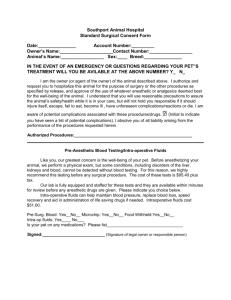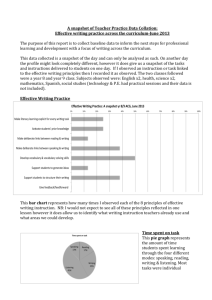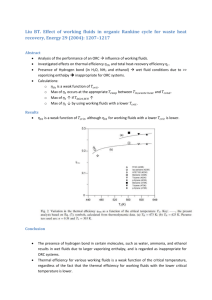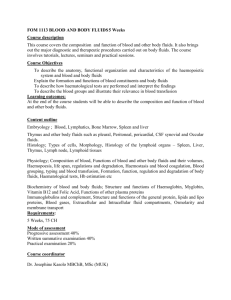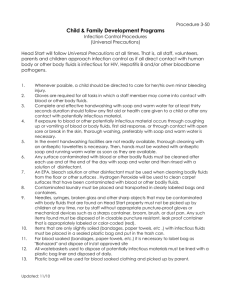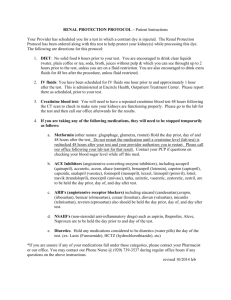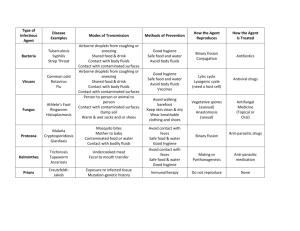01 The Nature of Fluids
advertisement
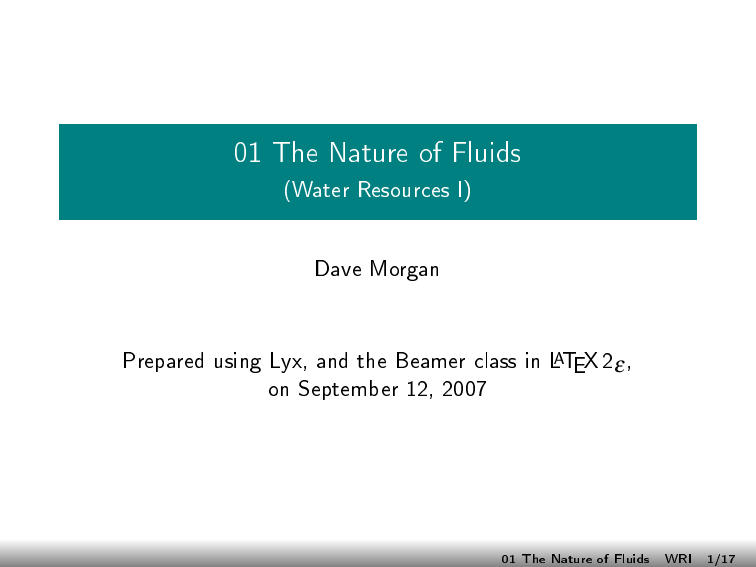
01 The Nature of Fluids (Water Resources I) Dave Morgan AT X 2ε , Prepared using Lyx, and the Beamer class in L E on September 12, 2007 01 The Nature of Fluids WRI 1/17 Recommended Text A recommended text to accompany these notes is Applied Fluid Mechanics by Mott: Read sections: 1.3, 1.4, 1.6 (omit US units), 1.7, 1.8, 1.9, 1.11 Study Example Problems: 1.5 - 1.9 01 The Nature of Fluids WRI 2/17 Elementary Properties of Fluids Fluids can be either liquid or gas A liquid tends to ow and conform to the shape of its container Liquids are not readily compressible (for the purpose of this course, we consider them to be imcompressible) A gas tends to expand to ll the closed container it is in (or to disperse if not contained). Gases are readily compressible We shall be primarily concerned with liquids 01 The Nature of Fluids WRI 3/17 Primary Units SI units are used. Four primary units will be used extensively in this course: Quantity SI unit Dimension Length metre, m L Mass kilogram, kg M Time second, s T Temperature Kelvin, K θ (Current and luminosity are the two other primary SI units.) 01 The Nature of Fluids WRI 4/17 Derived Units Quantity SI Unit velocity m/s LT −1 2 LT −2 acceleration m/s force N, newton energy J, joule (work) N·m 2 kg·m/s kg m power 2 /s2 N · m/s Dimensions MLT −2 2 −2 ML T 2 −3 ML T J/s pressure (stress) Pa, pascal 2 N/m kg/m/s ML −1 T−2 2 01 The Nature of Fluids WRI 5/17 Derived Units: Quantity SI Unit Volume ow rate, Q 3 m /s Dimensions 3 −1 L T L/s Weight ow rate, Mass ow rate, Specic weight, Density, ρ W N/s 2 kg/m/s M kg/s γ N/m 3 kg/m 3 −1 S−2 ML MT −1 −2 T−2 ML ML −3 01 The Nature of Fluids WRI 6/17 Pressure Pressure is given by: p= F A It is the force per unit area on a surface, where 2 1 N/m = 1 Pa (pascal) 01 The Nature of Fluids WRI 7/17 Pressure Pressure is given by: p= F A It is the force per unit area on a surface, where 2 1 N/m = 1 Pa (pascal) Blaise Pascal (1623 - 1662), after whom the Pascal programming language was named, determined the following principles: 1 Pressure acts uniformly in all directions on a small volume of a uid at rest 2 In a uid conned by solid boundaries, pressure acts perpendicularly to the boundaries 01 The Nature of Fluids WRI 7/17 Pascal's Laws Pressure acts uniformly in all directions on a small volume of a uid at rest. The forces must balance out (i.e. Σ Fx = Σ Fy = 0); otherwise the volume of uid will not be in equilibrium and cannot remain at rest. Also, the volume must be suciently small that we do not have to consider the mass, and therefore the weight, of the volume of uid. If the weight is not negligible, the upward pressure on the bottom of the volume will have to be greater than the downward pressure on the top of the volume so that Σ Fy = Fup − W − Fdown = 0. 01 The Nature of Fluids WRI 8/17 Pascal's Laws In a uid conned by solid boundaries, pressure acts perpendicularly to the boundaries. Why is this true? (Consider a small volume of uid at rest against one of the boundaries? If this volume remains at rest, what are the forces that act upon it?) 01 The Nature of Fluids WRI 9/17 Density Density is mass per unit volume: ρ= m V 01 The Nature of Fluids WRI 10/17 Density Density is mass per unit volume: ρ= ◦ m V ◦ The density of water between 0 C and 15 C is close to 3 1000 kg/m . ◦ It has a maximum density at 4 C. ◦ 3 Above 15 C, the density drops steadily to a density of 958 kg/m ◦ at 100 C. (There is a table of values for the properties of water at the back of Applied Fluid Mechanics by Mott, or from numerous other sources) 01 The Nature of Fluids WRI 10/17 Specic Weight Specic weight is weight per unit volume: γ= w V 01 The Nature of Fluids WRI 11/17 Specic Weight Specic weight is weight per unit volume: γ= w V 3 between 0 ◦ C and 15 ◦ C. Water has a specic weight of 9.81 kN/m 01 The Nature of Fluids WRI 11/17 Specic Weight Specic weight is weight per unit volume: γ= w V 3 between 0 ◦ C and 15 ◦ C. Water has a specic weight of 9.81 kN/m Since w = mg , it follows that: γ= w mg = = ρg V V 01 The Nature of Fluids WRI 11/17 Specic Gravity Specic gravity is the ratio of the density (or specic weight) of a ◦ substance to the density (or specic weight) of water at 4 C. Then, the specic gravity of a substance sg = γs γw @ 4 ◦ C = s is given by ρs ρw @4 ◦ C 01 The Nature of Fluids WRI 12/17 Specic Gravity Specic gravity is the ratio of the density (or specic weight) of a ◦ substance to the density (or specic weight) of water at 4 C. Then, the specic gravity of a substance γs sg = γw @ 4 ◦ C = s is given by ρs ρw @4 ◦ C ◦ 3 and the density of The density of gasoline at 25 C is 680 kg/m ◦ 3 . Therefore, the specic gravity of water at 4 C is 1000 kg/m ◦ gasoline at 25 C is sg = 680/1000 = 0.68. 01 The Nature of Fluids WRI 12/17 Specic Gravity Specic gravity is the ratio of the density (or specic weight) of a ◦ substance to the density (or specic weight) of water at 4 C. Then, the specic gravity of a substance γs sg = γw @ 4 ◦ C = s is given by ρs ρw @4 ◦ C 3 and the density of ◦ The density of gasoline at 25 C is 680 kg/m ◦ 3 . Therefore, the specic gravity of water at 4 C is 1000 kg/m ◦ gasoline at 25 C is sg = 680/1000 = 0.68. ◦ The specic weight of mercury at 25 C is 132.8 kN/m 3 and the ◦ 3 specic weight of water at 4 C is 9.81 kN/m so the specic ◦ gravity of mercury at 25 C is sg = 13.54 01 The Nature of Fluids WRI 12/17 Nature of Fluids Example Calculate the pressure produced in the oil in a closed cylinder by a piston with diameter 7.5 cm exerting a force of 11 175 N 01 The Nature of Fluids WRI 13/17 Nature of Fluids Example Calculate the pressure produced in the oil in a closed cylinder by a piston with diameter 7.5 cm exerting a force of 11 175 N 11175 N 7.5 cm 01 The Nature of Fluids WRI 13/17 Nature of Fluids Example Calculate the pressure produced in the oil in a closed cylinder by a piston with diameter 7.5 cm exerting a force of 11 175 N 11175 N Solution p = = F A 11175 N π(0.075)2 /4 m2 = 2529500 Pa = 2.53 MPa 7.5 cm 01 The Nature of Fluids WRI 13/17 Nature of Fluids Example Calculate the weight of 1 m 3 of kerosene if it has a mass of 823 kg 01 The Nature of Fluids WRI 14/17 Nature of Fluids Example Calculate the weight of 1 m 3 of kerosene if it has a mass of 823 kg Solution W Note: = mg 2 = 823 kg × 9.81 m/s = 8070 N In general, use 5 signicant gures for interim calculations and 3 signicant gures for displayed solutions. 01 The Nature of Fluids WRI 14/17 Nature of Fluids Example Calculate the density and the specic weight of benzene if its specic gravity is 0.876. 01 The Nature of Fluids WRI 15/17 Nature of Fluids Example Calculate the density and the specic weight of benzene if its specic gravity is 0.876. Solution ρb ρwater @4◦ C ρb = 0.876 × 1000 kg/m3 = 876 kg/m3 0.876 = γb γwater @4◦ C γb = 0.876 × 9.81 kN/m3 = 8.59 kN/m3 0.876 = 01 The Nature of Fluids WRI 15/17 Nature of Fluids Example ◦ A cylindrical tank with diameter 12.0 m contains water at 20 C to ◦ a depth of 4.0 m. If the water is heated to 65 C, what is the depth of the water? (Assume that the tank dimensions remain constant and that there are no losses due to evaporation.) 01 The Nature of Fluids WRI 16/17 Nature of Fluids Example ◦ A cylindrical tank with diameter 12.0 m contains water at 20 C to ◦ a depth of 4.0 m. If the water is heated to 65 C, what is the depth of the water? (Assume that the tank dimensions remain constant and that there are no losses due to evaporation.) Solution ◦ Volume at 20 C: V20 = π d 2 h20 4 = π(12.0 m)2 (4.0 m) 4 = 452.39 m3 Mass of water in the tank: m = ρ V20 = 998 kg/m3 × 452.39 m3 = 451490 kg ...continued 01 The Nature of Fluids WRI 16/17 Nature of Fluids Solution (continued) V20 = π d 2 h20 4 = π(12.0 m)2 (4.0 m) 4 = 452.39 m3 m = ρ20 V20 = 998 kg/m3 × 452.39 m3 = 451490 kg ◦ Volume at 65 C: V65 = m ρ65 = 451490 kg 981 kg/m3 = 460.23 m3 ◦ Depth at 65 C: h65 = 3 V 4 × 460.23 m = = 4.0639 m πd2 π(12.0)2 4 65 ◦ The depth at 65 C is 4.06 m 01 The Nature of Fluids WRI 17/17
